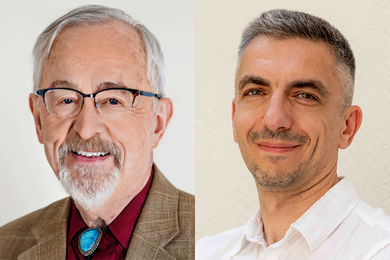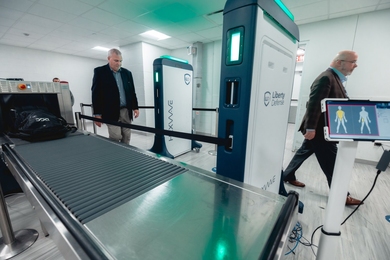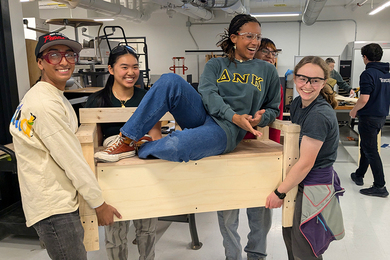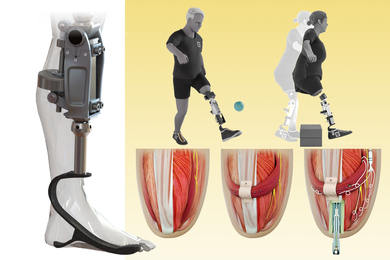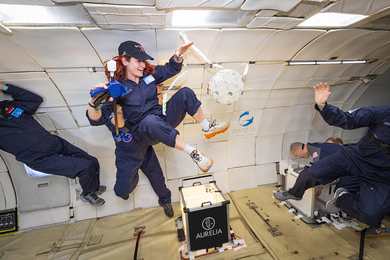One MIT alumnus came back to hear Professor Alan Lightman read from his best-selling novel, Einstein's Dreams, and to see a performance by his favorite professor, playwright A.R. (Pete) Gurney. Another returned not only to see her architecture classmates but to tour MIT's new biology building and its commissioned art works. And while some alums recalled their musical moments at MIT as they sang together on the stage of Kresge Auditorium, others discovered the latest uses of computers in artistic expression in MIT's Media Laboratory.
All were among the record number of alumni, alumnae, family and guests who attended Alumni/ae Week and Technology Day 1994, which for the first time celebrated and showcased MIT's programs in the creative arts.
Titled "For the Wonder of It All: The Arts at MIT," Technology Day (June 3) was the centerpiece of a week which brought nearly 3,000 alumni/ae and guests to campus for reunion activities. The day-long series of presentations attracted an overflow audience to Kresge Auditorium for the morning program featuring Institute Professor Emeritus Philip Morrison, architect I.M. Pei '40, Tallix Incorporated President Richard Polich '65, and MIT composers John Harbison and Tod Machover. Participants also attended afternoon sessions featuring music, theater, creative writing, architecture and design, and computer-driven art.
"The arts at MIT are essential elements of our education and of our community," President Charles Vest said in his welcome to the morning session at Kresge. "Not only are they healthy here, they are thriving," he said, calling this a "great testimony to the talent, the dedication, and the enthusiasm of so many of our faculty and students."
For many returning alumni/ae, Dr. Vest's words came as no surprise. "The arts have always been here," said George Berbeco '66, who, as an undergraduate, took "every course taught" by his "hero," literature professor A.R. Gurney, who is now on leave from MIT. "I think it's super that Tech Day is focusing on a side of MIT that has always been around but has been understated."
"Technology shines here, but the arts have been a neglected area," echoed George Clifford '48 who played drums in a swing band called the Techtonians and enjoyed singing at fraternity parties in his student days. "It's wonderful to see the arts have their day," said Mr. Clifford, who served as chairman of the 1991 Technology Day Committee and sings in a community chorale.
The week's activities kicked off with a rousing Tech Night at the Pops under the direction of Boston Pops Laureate Conductor John Williams. The program featured a performance of "Remembering Gatsby: A Foxtrot for Orchestra," written by Class of 1949 Professor John Harbison, and a performance of Ravel's Piano Concerto in G by music Lecturer and pianist David Deveau. It was a surprise appearance by former MIT president and Chairman of the MIT Corporation Paul Gray, however, which brought alums to their feet as he conducted the orchestra in an energetic rendition of The Stars and Stripes Forever. Dr. Gray's Boston Pops debut prompted William Hecht, executive vice president of the MIT Alumni/ae Association, to inform the Friday morning audience in his opening remarks that the concert was "actually a test for the potential new conductor for the Pops!"
Hosted by Associate Provost for the Arts Ellen T. Harris, the morning program opened with remarks by Professor Morrison, who invoked the theme of mens et manus ("mind and hand") in emphazing the historical connection between art and science at MIT and beyond, and stressed the importance of "playful engineering."
Mr. Pei entertained and fascinated alumni/ae with his description of the technical, organizational and political challenges involved in creating his recent glass "pyramid" addition to the Louvre museum in Paris. Engineer Richard Polich led the audience on a "tour" of his art foundry, Tallix Incorporated, where metal sculptures up to 50 feet high are created, and discussed the relationship between artist, fabricator and engineer. To close the morning program, classical music critic Lloyd Schwartz engaged professors Harbison and Machover in a conversation about their compositional styles, their respective work with cellist Yo-Yo Ma and their work in relation to the Institute.
MIT's visual art and architecture were featured on Saturday, as alumni/ae and their guests enjoyed guided tours of the new biology building, the List Visual Arts Center's current exhibitions, MIT's outdoor sculpture collection, and collections of the MIT Museum. In addition to presenting tours of its holography collection, architectural collections and Hart Nautical Collections, the Museum was also the site of an opening reception for its new retrospective exhibition, "Light/Space/Time: CAVS/MIT/25 Years," where guests climbed Christopher Janney's musical Soundstairs to view the technological creations of former fellows of MIT's Center for Advanced Visual Studies.
For some alumni/ae, the highlight of Tech Day/Alumni/ae Week came on Sunday afternoon, when playwright A.R. (Pete) Gurney and actress Kitty Carlisle Hart, a member of the Council for the Arts at MIT, performed Gurney's play, Love Letters, for an intimate audience in Lobdell Dining Hall. After the play, audience members filed out into the sunshine for a reception in front of the Student Center, and fans and former students crowded around Gurney and Hart to offer their congratulations and best wishes. What was perhaps the most unusual reunion of the weekend took place there between two MIT-affiliated artists, as Richard Whiting '26 a civil-engineer-turned-actor, offered his greetings to a surprised Ms. Hart. The two, it seems, had appeared together in the recent film, Six Degrees of Separation.
A version of this article appeared in the June 15, 1994 issue of MIT Tech Talk (Volume 38, Number 36).
